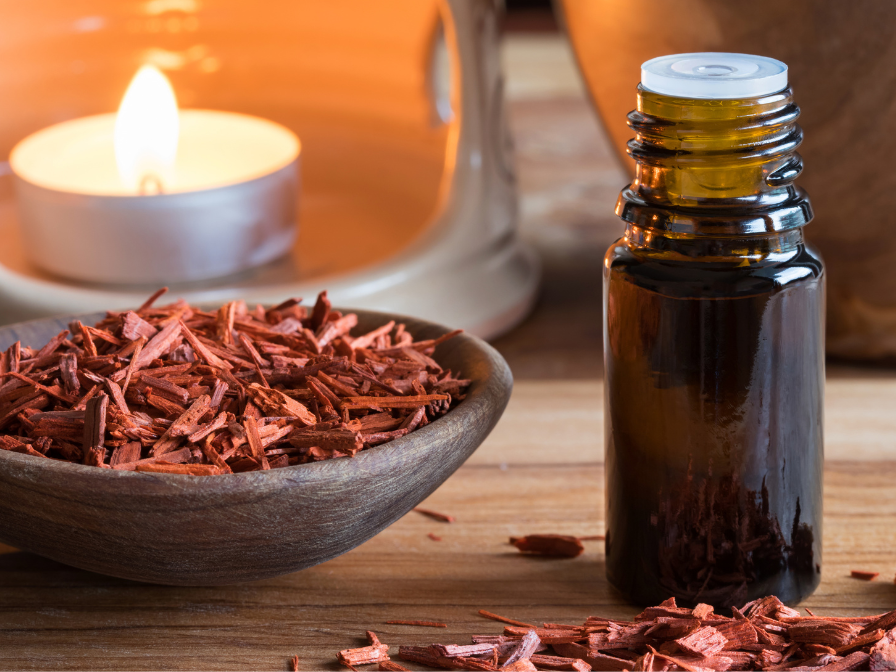Sandali (Sandalwood) – Fragrant Calm for Your Skin
Siri za Urembo wa Asili na Mariam
ANCIENT BEAUTY SECRETS
4/3/20255 min read


A Fragrant Treasure from Our Heritage
Sandali, or sandalwood, is a cherished ingredient in our traditional skincare practices. This aromatic wood has been valued for centuries not just for its distinctive fragrance but also for its remarkable ability to calm and balance the skin.
Unlike many trendy ingredients that come and go, Sandali has stood the test of time, remaining a constant in traditional beauty rituals across generations. Its gentle yet effective properties make it particularly valuable in today's world of harsh, synthetic skincare products.
Why Sandali Deserves a Place in Modern Skincare
Sandalwood offers several benefits that make it relevant even in today's crowded skincare market:
Natural Anti-inflammatory: Helps reduce redness and soothe irritated skin without harsh chemicals.
Balancing Properties: Works to normalize both dry and oily skin conditions, making it versatile for different skin types.
Gentle Astringent: Tightens pores and tones skin without the drying effects of alcohol-based products.
Aromatherapeutic Benefits: Its warm, woody scent has calming properties that benefit both skin and mind during application.
Antimicrobial Action: Natural compounds in sandalwood help combat bacteria that can contribute to skin issues.
The Science Behind Sandali's Benefits
Traditional knowledge about sandalwood's skincare benefits is increasingly supported by modern research. Studies published in the Journal of Ethnopharmacology have documented sandalwood's anti-inflammatory and antimicrobial properties.
Research has identified alpha-santalol as the primary active compound in sandalwood, responsible for many of its skin-soothing effects. This compound has been shown to help reduce inflammatory markers in skin cells and inhibit certain bacteria, supporting its traditional use for calming irritated skin and promoting healing.
Additionally, studies suggest that sandalwood's astringent properties come from natural tannins that gently tighten skin tissue without causing excessive dryness—a balance that's difficult to achieve with synthetic astringents.
How to Incorporate Sandali Into Your Routine
Adding this traditional ingredient to your skincare regimen can be done in several ways:
Sourcing Quality Sandali
Look for authentic sandalwood powder that maintains its natural aroma and beneficial properties.
When possible, choose ethically sourced sandalwood to support sustainable harvesting of this precious resource.
Pure sandalwood oil (often called sandalwood essential oil) is another option, though it should always be diluted before skin application.
Simple Sandali Mask
This basic mask harnesses sandalwood's calming properties:
Ingredients:
1 teaspoon sandalwood powder
2 teaspoons rose water (or plain water if rose water isn't available)
Optional: ½ teaspoon honey for additional soothing benefits
Preparation:
Combine ingredients in a small, non-metallic bowl until you achieve a smooth paste.
Apply to clean skin, focusing on areas with redness or irritation.
Leave on for 10-15 minutes.
Rinse gently with lukewarm water.
Follow with your regular moisturizer.
Sandali Spot Treatment
For targeted application to irritated areas:
Ingredients:
½ teaspoon sandalwood powder
A few drops of water or aloe vera gel
1 drop of suitable carrier oil (like jojoba or almond oil)
Application:
Mix to form a small amount of paste.
Apply directly to irritated spots or breakouts.
Leave on for 15-20 minutes or overnight for stubborn spots.
Rinse gently.
Adapting Sandali for Different Skin Needs
Sandalwood can be customized for various skin concerns:
For Dry or Sensitive Skin: Mix sandalwood powder with a bit of milk or cream instead of water for added moisture and gentleness.
For Oily or Acne-Prone Skin: Combine with a small amount of turmeric (about ¼ the amount of sandalwood) and a few drops of lemon juice for enhanced clarifying effects.
For Mature Skin: Blend with a few drops of almond oil and a pinch of ground flaxseed for additional nourishment and antioxidant benefits.
For Uneven Skin Tone: Mix with equal parts chickpea flour (besan) and a touch of honey to help brighten and even out the complexion.
Important Considerations When Using Sandali
While Sandali is generally gentle, there are some important things to keep in mind:
Use Sparingly: Sandalwood is potent—a little goes a long way. Using too much or too frequently can sometimes lead to dryness.
Frequency: Traditional practices recommend using sandalwood treatments once every couple of weeks rather than daily, allowing your skin to benefit without overwhelming it.
Patch Testing: Always test any new ingredient on a small area first, particularly if you have sensitive skin or allergies.
Pregnancy Considerations: Some aromatherapists recommend avoiding sandalwood during pregnancy—consult with a healthcare provider if this applies to you.
Authenticity Matters: Real sandalwood has become expensive and rare, leading to many substitutions in the market. The beneficial properties come from genuine sandalwood, so sourcing quality matters.
Sustainable and Ethical Considerations
True sandalwood (Santalum album) has faced overharvesting issues, making sustainability an important consideration:
Look for sandalwood sourced from managed plantations rather than wild-harvested sources.
Australian sandalwood (Santalum spicatum), while slightly different in fragrance profile, offers similar skincare benefits with less environmental concern.
Consider using sandalwood products sparingly out of respect for its limited availability and to extend the life of your supply.
Support brands and sources that provide information about their sandalwood sourcing practices.
Cultural Significance Beyond Skincare
What makes Sandali particularly special is its place in cultural traditions beyond just beauty:
In many traditions, sandalwood has been used in religious ceremonies and rituals, giving it significance that transcends its physical properties.
The act of applying Sandali connects us to ancestral knowledge and practices, creating a moment of cultural continuity in our modern lives.
Unlike trendy ingredients that appear suddenly in the beauty market, sandalwood carries centuries of documented use and refinement.
This cultural dimension adds a meaningful layer to the skincare experience, transforming a simple mask application into a connection with heritage and tradition.
Complementary Ingredients from Our Traditions
Sandali works beautifully with other traditional ingredients:
Rose water: Enhances sandalwood's soothing properties while adding hydration.
Turmeric (Manjano): A small amount combined with sandalwood creates a powerful calming and clarifying treatment.
Honey (Asali): Adds humectant properties that complement sandalwood's balancing effects.
Yogurt: Provides gentle exfoliation through lactic acid while diluting sandalwood to an appropriate strength.
My Journey with Sandali
I've been incorporating Sandali into my skincare routine gradually, observing how my skin responds to this traditional ingredient. What I've noticed most is its calming effect on irritation—areas of redness that didn't respond to modern products have shown improvement with regular sandalwood treatments.
The ritual of preparing and applying a Sandali mask has also become a grounding practice in my busy life. There's something deeply satisfying about working with an ingredient that has such a rich history and distinct aroma, connecting beauty practices to something more meaningful than just appearance.
Exploring Sandali in Your Skincare Routine
If you're curious about introducing this traditional ingredient to your routine:
Start with a simple mask using just sandalwood powder and water to observe how your skin responds.
Use it as a targeted treatment first, rather than applying to your entire face.
Pay attention to both the physical effects on your skin and the aromatherapeutic effects of the sandalwood scent.
Keep track of how your skin responds, adjusting frequency and combinations accordingly.
I plan to experiment with different Sandali blends and applications in the coming months, testing combinations with other traditional ingredients to find the most effective formulations. I'll be sharing these explorations in upcoming videos, documenting both the recipes and results.
Remember: Traditional ingredients like Sandali remind us that effective skincare doesn't need to be complicated or full of synthetic ingredients. Sometimes the most powerful remedies are the ones that have been proven through generations of use.
Join the Maris Community
© 2025 Maris Speak Up. All rights reserved.
Your privacy is important to me. Rest assured, your email will never be shared or sold.
Info@marissustainableskincare.com
Our official email
Join our community of early supporters and get exclusive benefits when we launch our skincare brand. As a founding insider, you’ll be the first to hear about product updates, enjoy early access, and receive special rewards made just for our day-one members. Plus, you'll get skincare tips and behind-the-scenes content as we build something meaningful together.
